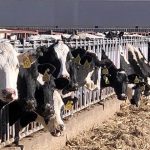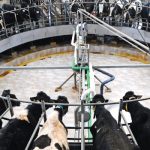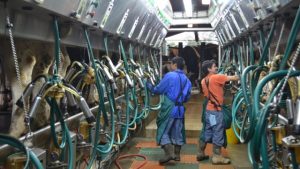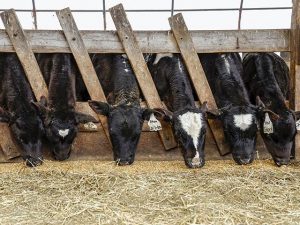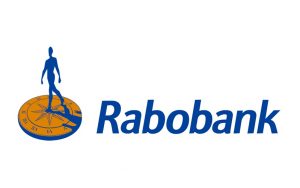
The mornings are early and the evenings run late when you care for dairy cows.
Glacier Edge Dairy, about 8 miles northeast of Janesville, is one of thousands of family-owned and -operated dairy farms in Wisconsin. In this case, the family is the Metcalfs – Terry and Jane, their children Lauren and Corey, and Corey’s wife, Kristen. “I love working as a team,” says Kristen, who manages the calves and marketing for the farm.
“I try not to call [the people who work here] our staff as much as possible because they’re really part of our team and our farm family. And I love working with our family every day, with my husband and his parents as well.” We spoke with Kristen about a typical day in the life on the farm.
4 a.m.
An employee feeds the cows a blend of corn silage, ground corn, forages, minerals and whey. Cows spend some of their day eating, some time ruminating – or digesting – their food, some milking, and the rest of their time is spent resting. They also drink a bathtub full of water each day. “Every decision we make is for the cows, like how can we help them live their best life,” Kristen says.
6 a.m.
The first of two 12-hour staff shifts begins – along with the first milking of the day. One employee does the milking, while another fetches the cows, cleans the pens and helps rotate the cows through the parlor – 24 at a time, five to 15 minutes per rotation. They run the milking parlor 21 hours a day, milking 750 cows and shipping out 50,000 pounds of milk daily.
Kristen and Corey get to the farm around this time, too. Kristen and a full-time employee feed and check on the 180 or so calves at the farm at any given time. Milk’s on the menu, of course. “We feed the younger part of our calves on bottles and then the older part of our calves are on buckets,” Kristen says. They fill a milk taxi, which warms and pasteurizes the milk, and haul it over to the calves using a UTV.
Corey checks the cows in the barn every morning. He gives vaccinations and looks after any sick ones.

11:30 a.m.
Kristen finishes up the calf chores. From there, the rest of her day can vary. When new calves are born, she tags, vaccinates and moves them outside. Every other week, the hoof trimmer comes, and Kristen helps sort the cows for their manicure.
On opposite weeks, the veterinarian visits the farm, and Kristen helps make sure he sees the right cows. “He is primarily checking for pregnancies in the herd. So we go along and check to see which cows are pregnant, which ones aren’t. But then he’s also checking on any sick cows,” she says.
2 p.m.
The day’s second round of milking begins.
5 p.m.
Kristen feeds the calves again, before starting to wrap up the day.
7 p.m.
On a normal day, Kristen and Corey leave around 6:30 or 7 p.m. – but on some days they stay as late as 10 or 11 p.m., if a cow is giving birth, if it is planting or harvesting season, if a cow is really sick or something else comes up.
10 p.m.
Staff begin the third and final milking rotation of the day.
You can now read the most important #news on #eDairyNews #Whatsapp channels!!!
🇺🇸 eDairy News INGLÊS: https://whatsapp.com/channel/0029VaKsjzGDTkJyIN6hcP1K

